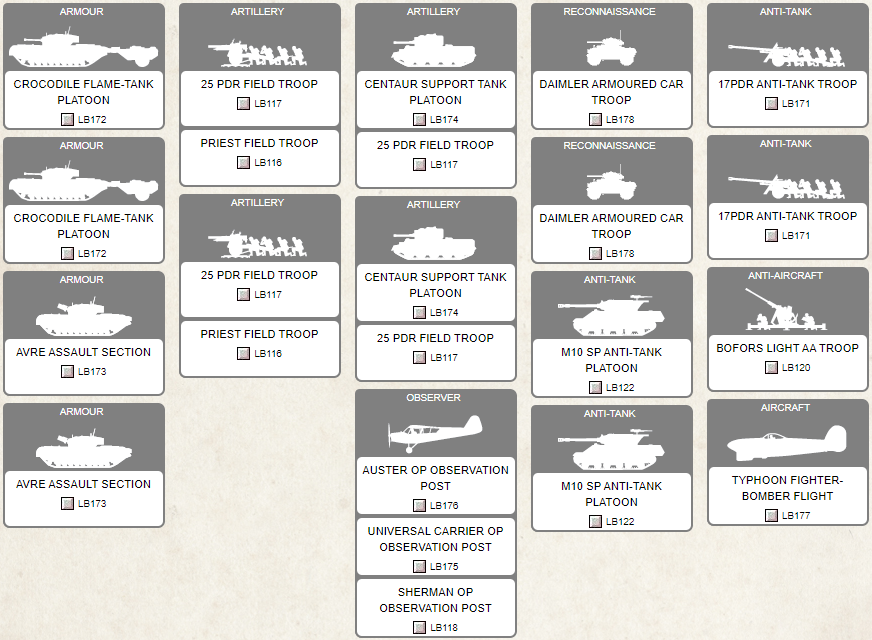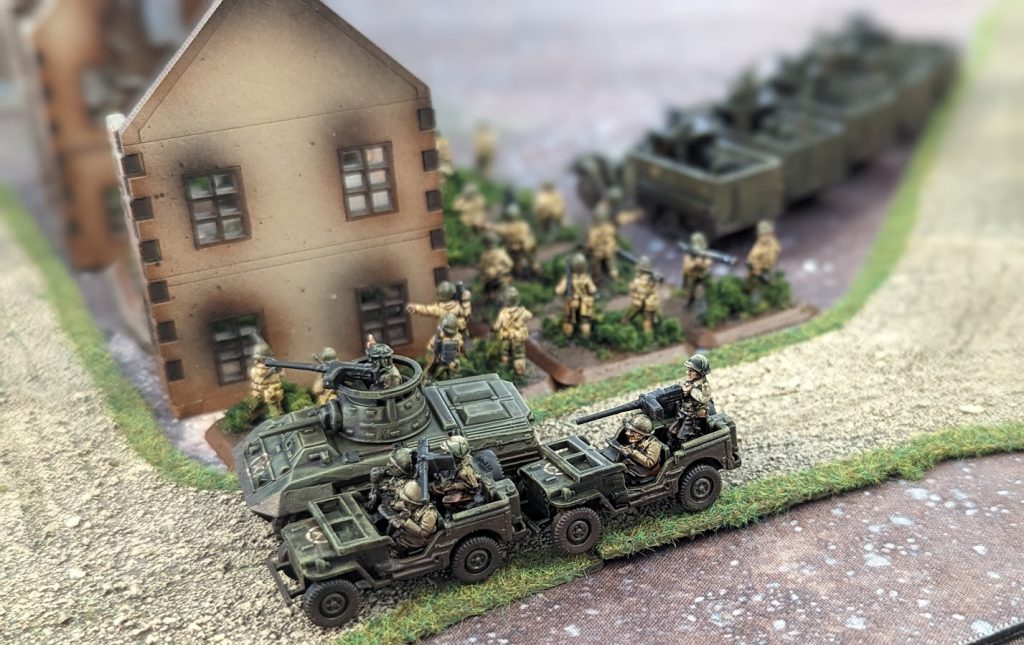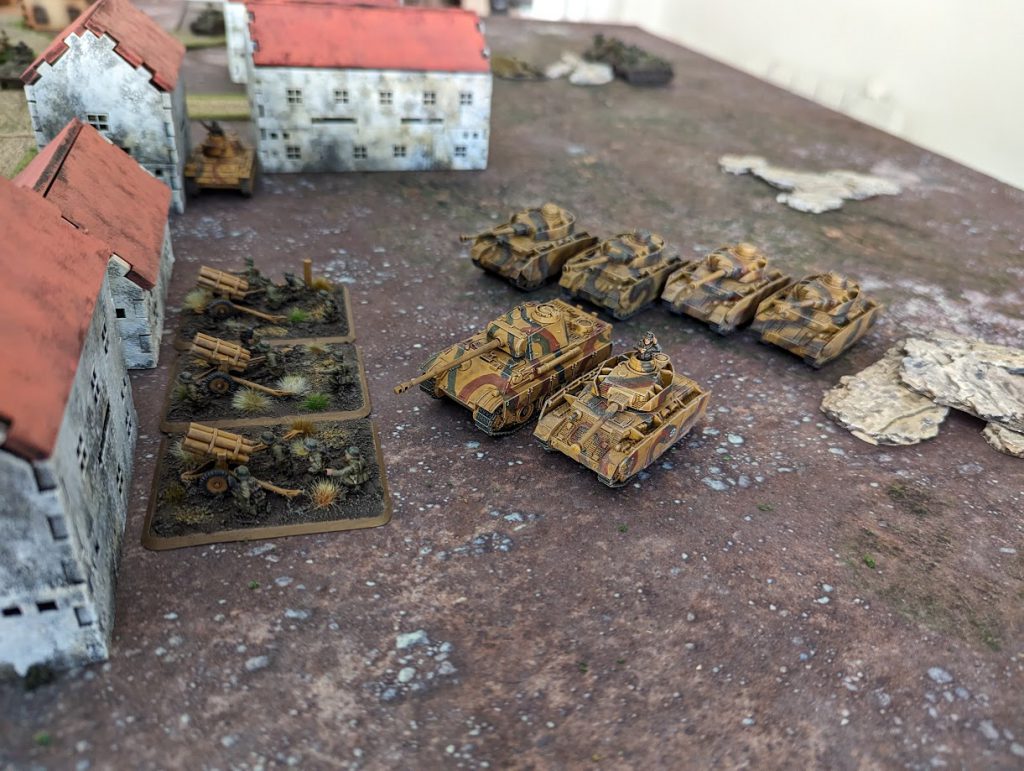What is Flames of War?
It’s Battlefront’s take on the company level second world war miniature wargame, at 15mm (or 1:100) scale, running on essentially the same core ruleset as their Team Yankee game (and ‘Nam, and Great War, and Fate of a Nation).
Why play it?
It’s the most popular WW2 miniatures game and sometimes, that’s all it takes. ‘Actually getting games in’ aside, the easiest way to understand Flames of War is that it’s the game of the movie of WW2. The game isn’t necessarily interested in recreating specific units and actions (though it does provide some tools to do so, if you’re so inclined) and has a tendency to approach each nation as more of a vibe than a science.
What the game is great at is providing you with lots of options and regularly serving up tense, cinematic moments. Scenarios are pitched at giving you room to manoeuvre, but still providing a need to eventually lunge in for a violent finish.
As a miniatures company, Battlefront put out some cracking plastic kits (alongside some older and ropier resin and metal minis for the less popular units) and have some incredibly good value starter set boxes, making it very easy to start.
What does an army look like?
Army design is scaled around the company level, and uses a combination of points and formations for army building. The game’s default assumption is playing to 100 points each, though you do see this number getting changed up by events more often than happens in Games Workshop related events.
The heart of army building is in formations, you have to take at least one (but can take more) and to a certain extent it will dictate which units you can take in your army. Outside of formations are support options, command cards and allies.

A formation will represent a specific type of company, and contain mandatory (‘black box’) units, as well as a series of optional ones. For example, a British Sherman Armoured Squadron has a mandatory HQ of 2-4 Shermans, a mandatory troop of two Shermans and a Firefly or three Shermans and a Firefly and then a third mandatory unit that is either the same Sherman options again or a recce patrol of 3-4 Stuarts. Then in the optional units there are two more troops of Shermans, one Stuart recce patrol, and a pretty ahistorical Crusader AA troop.
This is a classic complicated to explain but simple to actually do situation, and building out a formation is pretty intuitive. Battlefront does provide their own decent web based army builder, though not for free.
Support options are a combination of single choices of “black box” units to more specialist units that don’t exist in any formation. So our British Sherman army could start taking Crocodiles, static guns and air alongside their Shermans.

Most armies also have the option to field an allied formation and/or allied unit, and command cards provide additional options to customise your army – like adding rules to represent specific units, tweaking equipment on a unit you’ve taken, or providing one-off effects during the game.
There’s no limit on how many points you have to spend on formations/support/allies, but there are some factors that are worth taking into account when designing your dream army. Firstly, Flames of War has a sudden death mechanic – if all of the units you have from formations are destroyed, you lose the game. This is a pretty direct incentive to either build a large formation, or to take more than one. Cheap in-formation mortar or infantry units are great for adding bulk that will keep you in the game, as are cheap recce formations. In addition to this, most missions involve some kind of reserve system (typically for the defender) where 40% of an army by points will have to start off the board. It’s usually worth thinking about what your reserves will be, and as each unit in reserve has to be rolled for to come on, it’s worth having as few units in reserve as possible (by having one or two expensive units for this express purpose). It isn’t always possible to be totally efficient here, but it’s worth considering.
Note that there’s a whole rabbit hole you can fall down with nations that have multiple books in each era (ie. Late war British have a D-Day book and a Bulge book representing 1944 and 1945 respectively), and picking and choosing between those in a single army, but that’s a bit beyond the scope of this article. Suffice to say, you can do it with some mild limitations.
What do the stat blocks mean?

For the most part it’s fairly intuitive: infantry and armour share the same basic stat block with motivation, skill and ‘is hit on’ values working in essentially the same way. On top of this infantry have a flat save and tanks will have specific armour values for their front, side and top.
Because it’s unusual, it’s worth noting that ‘is hit on’ means that you’re not using your own unit’s stat for determining how likely it is to hit the enemy. Instead, you look at your opponent’s hit on value (typically a 3+ or 4+), modify as appropriate for things like range and special rules, and use this to determine the dice rolls you need to successfully shoot them.
Motivation and skill are umbrella stats that cover a variety of different tests your units might be called on to make in the game. For example: skill is used to pass movement orders (like shooting and scooting), range in artillery, and assault. Some units will have modifications to their base stat for thematic reasons, and this is reflected in a different stat for one or two specific things. So our example Battle Weary Rifles above could use their Yankee Ingenuity to pass movement orders on a 3+, but would need to roll a 4+ in order to range in artillery or conduct an assault.

How does it play?
At its heart, Flames of War is an old school system, and anyone who has played some older editions of Warhammer 40k will recognize the rhythm of the game. Turns are taken in a you-go-I-go fashion and there’s no fancy initiative system – the scenario will dictate who goes first and it proceeds from there. There are, however, a lot of different scenarios on offer and whilst they revolve around taking objectives there’s a lot of variety in deployment layout and reserves that keeps things fresh. Battlefront do include a fun way of generating a scenario with players secretly choosing to attack, defend or manoeuvre and rolling on a matrix to determine the game setup.

A good proportion of the scenarios don’t start checking for victory conditions until the sixth turn, so games aren’t always an instant rush towards arbitrary points on the board. Most armour has a ‘tactical’ move of 10” and dash speeds much higher than that, so there’s often time and space to get into position before engaging in earnest.
On top of this, lethality in FoW (especially compared to Team Yankee) is quite low – long range engagements will typically involve small numbers of dice being thrown, each with only a small probability of achieving a kill. The basic rhythm of shooting is: roll dice equal to your rate of fire, pick out hits, opponent rolls their saves and then any failed saves are rolled for again by the attacking player against their Firepower stat looking for an actual kill. Failing Firepower will result in a bailed out tank and perfectly healthy infantry.
It’s notable that infantry are particularly tough to shift – with a few exceptions they have a flat 3+ save against incoming fire, and most anti-infantry weapons are low Firepower and better at pinning than killing. Because you check to un-pin at the start of your turn before moving, a commander with particularly brave infantry can keep them in the fight for a long time (just watch out for leaving cover, when incoming fire doesn’t require Firepower to kill). Things get more lethal as the distance closes, assaults in particular are bloody affairs that can decide the game.
Are there issues with it?
As of writing, there’s quite a lot missing from what you would expect of a WW2 game – there’s no early war and no far east/Pacific theatre. Battlefront have been slow-rolling the content out for v4 of the game, and the pandemic hit them hard with their factory getting shut down for an extended period. They’ve promised this will all be coming, with the Pacific coming in 2024, but it’s not here yet.
A perennial complaint about Flames is the “parking lot” – where lots of vehicle models can end up jammed together on the board in a way that isn’t particularly historically accurate or aesthetically pleasing. Truthfully this is more of a problem in Team Yankee, where the large-scale inclusion of IFVs and APCs boosts your vehicle count to very high levels, but it can definitely happen in Flames of War too. If this is a problem for you there are a couple of solutions available: play lower points (you see 75 get banded about as a good level for Team Yankee for this reason), or just don’t take a spam list. You don’t have to take 30 T-34s, and if you do then expect to run into this.
Finally it would be remiss of us not to point out that Battlefront are quite happy to sell you SS themed accessories (dice and tokens). How far to engage with this stuff as part of the game is always going to be a difficult, personal thing (I personally probably wouldn’t want to play a game involving Hitler Youth, but I can understand why someone else might want to) but selling actual merch of it is extremely distasteful and by far the most off-putting part of the game.

So what nations are supported?
We’ll cover each nation in their own overview article, but for an idea of what’s on offer:
- America starts the Mid War as an inexperienced army with a lot of high quality kit, with Armoured Rifles being a particularly well equipped infantry formation. Going into Late War, America relies on a profusion of solid M4 variants to get the job done – but lacks for the true single all-rounder tank that other nations get.
- The Axis Allies book covers Hungary, Romania and Finland. The first two are provided with various German tanks, Hungarians being notable for having access to the more quality hardware but utilising generally worse stats than Germans to get it cheaper. Romanians exist to answer the question of what if you wanted to use an Early War army in Late War, and the Finns predictably field extremely high quality infantry and a variety of looted Soviet tanks.
- Britain spends the Mid War sending hordes of appallingly bad tanks forward to die in droves, backed up by solid infantry and excellent artillery. By the Late War, Britain is an army of generic soft stats and extremely specialised hardware – the Achilles tank destroyer has defined the Late War anti-tank role. A particular speciality of the British in FoW is possessing a variety of recce/armoured car formations that live in the command cards.
- As you might expect, Germany has the biggest range of stuff available to anyone. In Mid War, they tend towards the elite end of stats – and tank formations in particular can become enormously expensive very quickly. By Late War there’s also a diversity of quality as well as hardware, with the option for some extremely flexible formations as units are cobbled together for the defence of Berlin.
- Italy only exists in Mid War and fields generally awful tanks and mediocre infantry, but makes up for it with an excellent self-propelled gun in the Semovente and plentiful access to high-end static anti-tank.
- The Soviet Union in Mid War can field very large numbers of terrible infantry, mediocre light/medium armour and great heavy tanks – they suffer from having a lot of units that are hit on a 2+ and a general lack of quality anti-tank weapons. By Late War there are options that span all the way from big formations of conscripts to incredibly elite units (notably, some of the most terrifying assault infantry in the game). They still lack for very high quality anti-tank in volume, but access to high rate of fire medium anti-tank makes up for it.

Where to start
Battlefront have a lot of starter boxes available, and they’re almost all an excellent place to start. The two-player starter boxes provide a small army each that can easily be grown into a larger collection, some are so good that the most common answer to “what shall I buy after Hit the Beach?” is “another Hit the Beach”. Split one with a friend and you can’t go far wrong.
Alongside the cheaper two-player boxes are the more expensive single-army boxes. These RRP for about 40% more than the true starter sets, but are groaning with plastic and tend to provide a relatively coherent 100 point army. These are more variable in how useful what you get in each box is (there are some infamously poor compositions, unfortunately for British players), but can still represent a good value way to get an army quickly, even if you don’t end up using everything in the box. Definitely keep an eye on ways to pick these up below RRP, as they can get very cheap on-sale.
What’s next?
We’ll have articles covering each playable nation in depth, looking at what’s available for them and how they play.
Questions, comments, suggestions? Send a Morse code signal to contact@goonhammer.com or leave a comment below.


